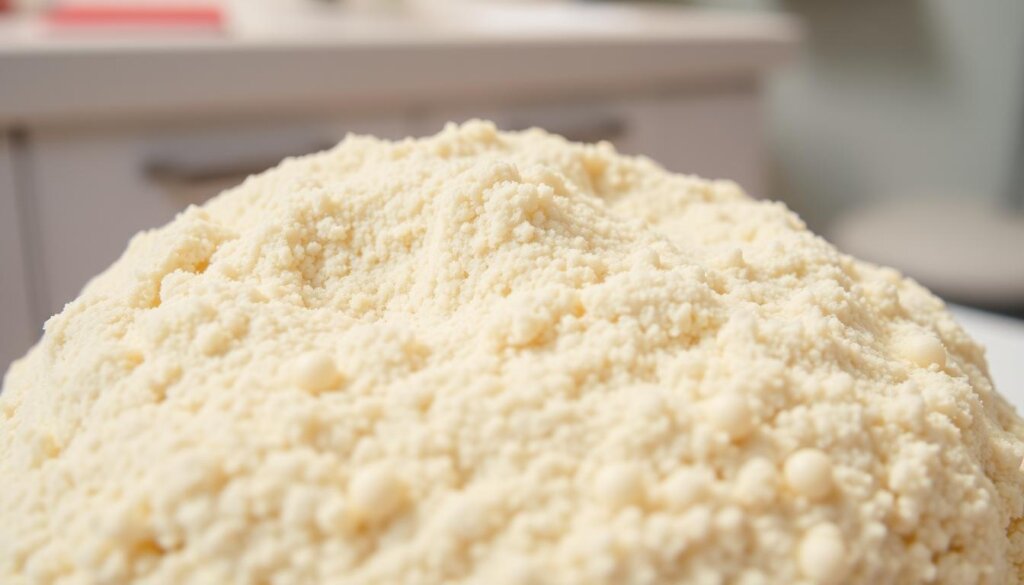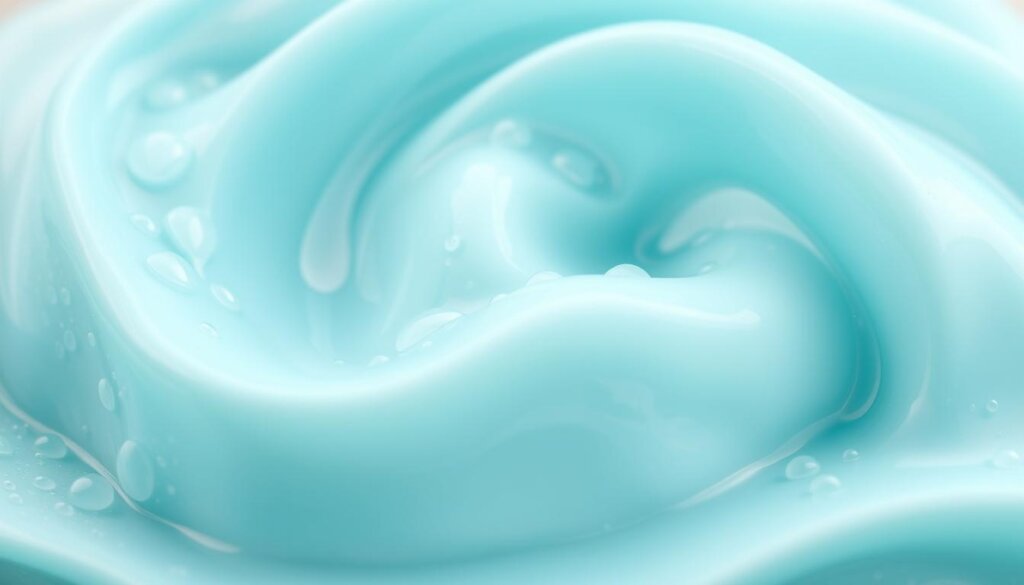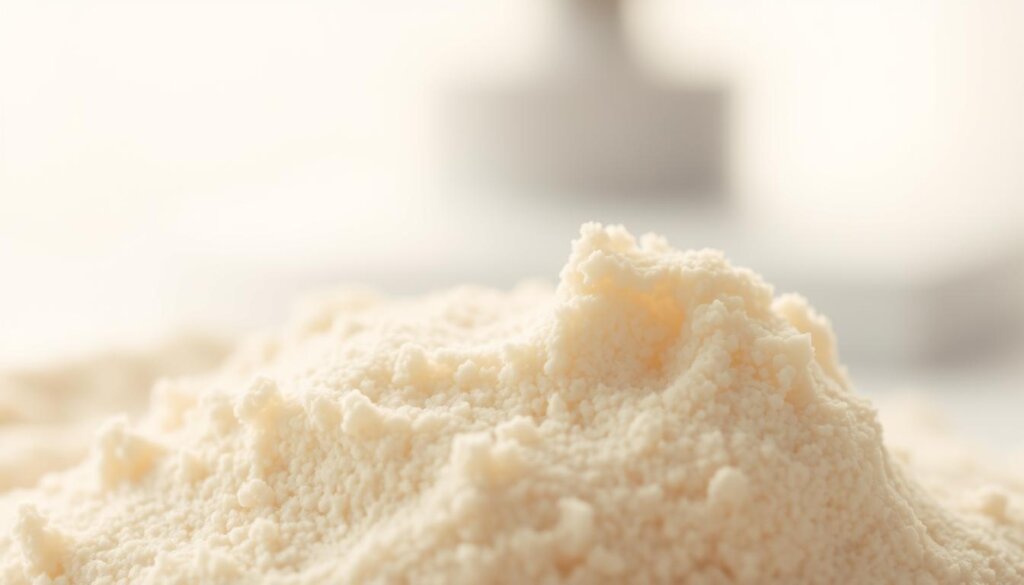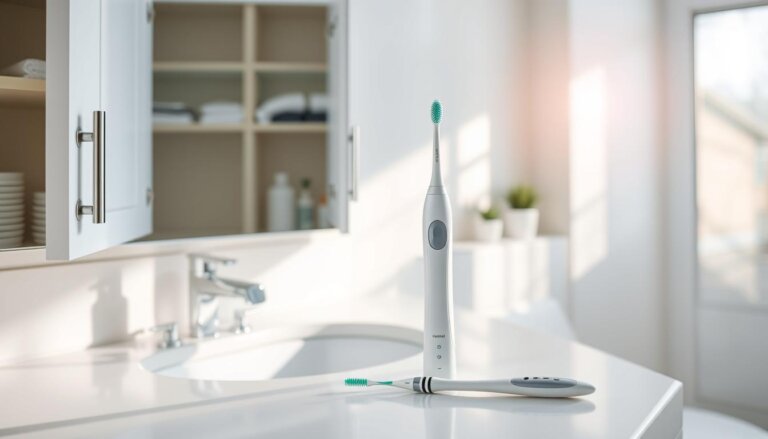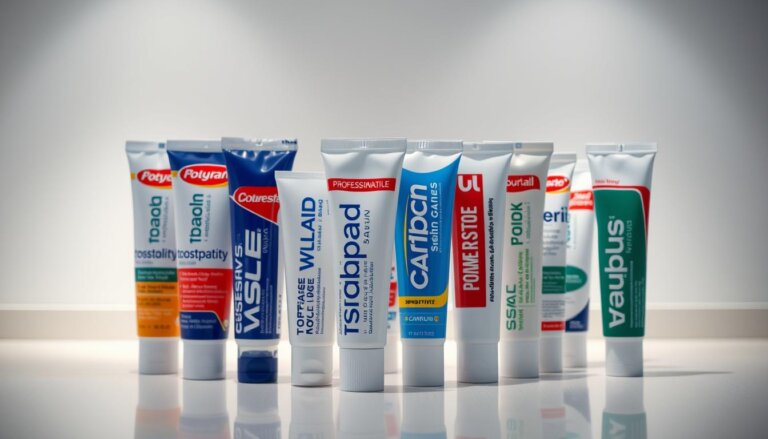What are the Gritty Paste and Fluoride Foam Used for in Cleanings?
Have you ever wondered why that “sand-like” polish and foam finish are used during a dental cleaning? Or if they really help prevent cavities?
This part explains the purpose of gritty paste and fluoride foam in cleanings. These tools are used by dentists to remove plaque mechanically and support the enamel chemically. This improves your oral health.
After checking your teeth and removing tartar, a hygienist uses prophy paste. This gritty substance polishes your teeth. It helps get rid of plaque and surface stains. This means bacteria have fewer places to hide in your mouth.
Then, they apply fluoride foam. This foam helps make your enamel stronger and fights off acids. Research has shown fluoride can lower the chance of cavities by up to 25%. So, it’s a key part of keeping your teeth healthy.
These steps make your teeth cleaner and your enamel stronger. This helps prevent tooth decay. Dentists recommend not eating or drinking for 30 minutes after fluoride to get the best results.
Key Takeaways
- Prophy paste is used during polishing to remove surface stains and support plaque removal after scaling.
- Fluoride foam reinforces enamel, aids remineralization, and lowers cavity risk in routine dental cleaning.
- The combined approach—mechanical cleaning plus fluoride—improves oral hygiene and long-term dental care outcomes.
- Smoother enamel from polishing reduces bacterial adherence between dental procedures.
- Post-fluoride guidance often includes a 30-minute pause on eating, drinking, or rinsing.
- Asking “What are the gritty paste and fluoride foam used for in cleanings?” helps patients understand evidence-based prevention.
Introduction to Dental Cleanings
Dental cleaning, also known as prophylaxis, is vital in dental care today. It aims to remove soft plaque and hard tartar. This keeps gums and enamel safe. Smoother teeth also make it easier to keep your mouth clean at home.
Why does this matter? Saliva turns plaque into hard calculus at the gumline. This calculus is full of bacteria and can cause gum inflammation. Regular dental visits break this harmful cycle.
Importance of Oral Hygiene
Good oral hygiene can lower your risk of getting cavities and gum disease. It helps keep your breath fresh. Cleaning your teeth regularly makes brushing and flossing at home much more effective.
- Stops harmful biofilm from growing.
- Makes it easier to remove plaque every day.
- Helps you get the most from dental products like fluoride toothpaste.
Most people should get their teeth cleaned twice a year. If you have had gum disease, you might need to go more often, maybe every three to four months.
Common Dental Cleaning Procedures
A typical dental visit includes several steps for deep cleaning. These steps ensure your teeth are clean, smooth, and safe.
- Checking teeth and gums for any problems.
- Using an ultrasonic scaler to break up tartar.
- Scraping teeth gently with special tools for a deep clean.
- Making teeth smooth with a prophy paste.
- Using floss to remove leftover bits.
- Applying fluoride to make enamel strong.
| Procedure Step | Primary Goal | Clinical Tools | Benefit to Dental Care |
|---|---|---|---|
| Assessment | Map plaque and calculus | Mirror, probe, radiographs as indicated | Targets precise plaque removal needs |
| Ultrasonic Scaling | Dislodge heavy tartar | Magnetostrictive or piezoelectric scaler | Efficient debridement with cooling spray |
| Hand Instrumentation | Refine and smooth surfaces | Scalers, curettes | Improves tissue response and comfort |
| Polishing | Reduce roughness | Prophy paste, rubber cup | Helps daily plaque removal at home |
| Flossing | Clean interproximal areas | Dental floss or tape | Complements oral hygiene between teeth |
| Topical Fluoride | Strengthen enamel | Foam, gel, or varnish | Supports long-term dental care outcomes |
What is Gritty Paste?
Gritty paste, or prophylaxis paste, is used in dental care for a special finish. It helps polish teeth by getting rid of stains and plaque without harming enamel. We focus on effective treatment and patient comfort, using top dental products safely.
Composition of Gritty Paste
It’s made with special abrasives like silica or calcium carbonate. These help remove biofilm and stains without wearing down enamel during polishing.
The paste stays together thanks to binders. Humectants keep it moist, and pH adjusters make it stable. It tastes good, coming in flavors like mint or cherry, using safe sweeteners. Trusted brands like 3M and Dentsply Sirona supply these ingredients.
Benefits of Using Gritty Paste in Cleanings
After scaling, dentists use a rubber cup to put the paste on teeth gently. This action helps get rid of plaque and stains from things like coffee.
This smoothing process means fewer bacteria can stick. So, it helps keep teeth clean longer. People feel their teeth are cleaner and look shinier, which also helps when they take care of their teeth at home.
What is Fluoride Foam?
Fluoride foam is a treatment used in dental offices after cleaning teeth. It is put in trays that fit over your teeth and covers them with a strong fluoride mix. This method is great for keeping your mouth healthy by targeting spots that are more open after cleaning.
Why foam? Foam’s tiny bubbles cover all parts of your teeth and limit how much fluoride you swallow. It’s only meant to be used on your teeth, not eaten.
Composition of Fluoride Foam
Fluoride foam has fluoride ions in a stable foam. In the US, there are mainly two types used by dentists: acidulated phosphate fluoride and neutral sodium fluoride. They work well on clean, dry teeth.
- APF: Good for healthy enamel; not for use on some restorations.
- Neutral NaF: Best for people with many fillings or who have sensitive teeth.
- Foam matrix: Designed to touch more of your tooth and less likely to be swallowed.
After the foam is put on, wait about 30 minutes before you eat, drink, or rinse. This break lets the fluoride work better, helping keep your teeth healthy until your next dental visit.
Benefits of Fluoride Foam in Oral Health
After a teeth cleaning, your enamel might be more open to damage. Fluoride treatments help fix and protect your teeth. People often feel less tooth pain from cold or sweet things after treatment.
- Helps fix small tooth damages by pushing fluoride deep into teeth.
- Makes teeth stronger against plaque after cleaning.
- Reduces the sharp pain from sensitive teeth by sealing off nerve paths.
- Works with daily brushing to add extra protection until your next dental check-up.
| Aspect | Clinical Rationale | Typical Setting | Post-Procedure Guidance |
|---|---|---|---|
| Chemistry (APF vs. NaF) | Balances uptake with restoration safety | Dental care visit after polishing | Select formula based on restoration status |
| Foam Delivery in Trays | Maximizes contact, minimizes ingestion | Chairside application by hygienist | Remove excess, expectorate thoroughly |
| Enamel Strengthening | Enhances mineral density and hardness | Immediately post dental cleaning | No eating or drinking for ~30 minutes |
| Sensitivity Reduction | Occludes tubules and stabilizes surfaces | Patients with cold or sweet triggers | Maintain consistent oral hygiene at home |
How Gritty Paste is Used in Dental Cleanings
After removing tartar, dental professionals polish teeth. This improves dental cleaning results. It also removes plaque and surface stains safely.
The process is the same in all modern dental cleanings. It promises reliable outcomes.
Application Process
A soft rubber cup, filled with polishing paste, is used. It’s on a tool that moves slowly. Each tooth gets polished carefully to get rid of leftovers and stains.
The type of paste used depends on the stains and gum health. Many dentists use silica in the paste to clean without hurting the teeth. After polishing, they floss to remove anything left and to keep gums healthy.
- Sequence: supragingival scaling → teeth polishing → flossing and rinse
- Technique: controlled speed, light pressure, brief contact per surface
- Goal: smooth surfaces that resist rapid biofilm accumulation
Recommended Frequency of Use
Usually, teeth get polished with a special paste every six months during cleanings. The exact timing can change. It depends on things like risk for cavities, stains, and gum disease history.
| Patient Profile | Typical Interval | Rationale | Home Care Note |
|---|---|---|---|
| Low caries risk, minimal stains | Every 6 months | Maintains results of scaling with conservative polish | Fluoride toothpaste aids daily plaque removal |
| Periodontal history or heavy stain | Every 3–4 months | More frequent dental procedures limit biofilm rebound | Adjunct interdental cleaning enhances dental cleaning effects |
| Orthodontic appliances | Every 4–6 months | Appliance surfaces harbor plaque and extrinsic stains | Use floss threaders or water flossers for access |
Brushing at home helps control plaque but can’t replace pro teeth polishing. The right choice of paste and method is important. This keeps teeth clean as part of overall dental care.
How Fluoride Foam is Applied During Cleanings
After cleaning your teeth well, the dentist puts on foam. This foam makes the outer layer of your teeth stronger and lowers the chance of getting cavities. It’s part of the fluoride treatments they do in the office and works well with the dental products they use.
Application Techniques
The dentist uses small, comfy trays that fit around your teeth to apply the foam. The foam grows to cover more of your teeth using less stuff than gels. This keeps you from swallowing it and makes the process quick.
They put the trays on your upper and lower teeth for a short while. A tool nearby removes any extra saliva. After, you spit out any leftover foam before getting up from the chair.
- Tray-based foam: covers a lot with a small amount.
- Tray-based gel: uses more stuff but works the same way.
- Varnish: a quick-setting coating brushed on teeth for long-lasting coverage.
Each choice suits various dental needs but all fit with the usual dental care during check-ups.
Duration of Treatment
The time the foam stays on your teeth is short—around 30 seconds. This quick process fits well into the busy schedule of a dental cleaning while still being effective.
After they put on the foam, you shouldn’t eat, drink, or rinse for at least 30 minutes. This allows the fluoride to work better with your at-home dental care, keeping your teeth strong between visits.
| Topical Form | Chairside Contact | Material Volume | Post-Procedure Guidance | Best Use Case |
|---|---|---|---|---|
| Foam (tray) | ~30 seconds | Low | No eating, drinking, or rinsing for 30 minutes | Routine preventive dental cleaning with reduced ingestion risk |
| Gel (tray) | ~1–4 minutes (practice-dependent) | Moderate | No eating, drinking, or rinsing for 30 minutes | Patients tolerating trays who need longer contact |
| Varnish (paint-on) | Sets quickly; adheres for extended contact | Very low | Avoid hard foods and brushing for several hours as directed | Younger patients, gag reflex concerns, or when prolonged contact is desired |
Comparison of Gritty Paste and Fluoride Foam
Both materials are common in regular dental cleanings, but they serve different purposes. One cleans the surface, while the other protects the enamel from within. Knowing the difference helps dentists choose the right product for each patient.
Key Differences in Purpose
Gritty paste, known as prophy paste, is used for polishing. It removes stains and biofilm, making it harder for bacteria to stick after a cleaning.
Fluoride foam is a chemical treatment that helps strengthen enamel and fight off cavities. It’s used after polishing to protect the tooth, not clean it.
- Gritty paste: physically polishes and refines the surface with abrasives.
- Fluoride foam: chemically enhances enamel with fluoride.
- Both products are essential for preventive dental care.
Effectiveness in Plaque Removal
Gritty paste plays a role in removing plaque by cleaning off surface biofilm and stains. This leaves a clean, smooth surface after a dental cleaning.
Fluoride foam doesn’t remove plaque. Instead, it lowers the risk of cavities once the plaque is gone. It aids in rebuilding enamel for healthier teeth over time.
| Aspect | Gritty Paste (Prophy Paste) | Fluoride Foam |
|---|---|---|
| Primary Role | Mechanical polishing and surface stain reduction | Chemical enamel strengthening and remineralization |
| Contribution to Plaque Removal | Directly removes surface biofilm during polishing | No direct plaque removal; acts post-cleaning |
| Timing in Dental Procedures | Before topical agents, during the polishing stage | After polishing, as a finishing therapy |
| Main Benefit in Dental Cleaning | Smoother enamel that can impede bacterial adherence | Enhanced caries resistance and support for early lesion repair |
| Representative Dental Products | 3M Clinpro Prophy Paste, Kerr Cleanic | Colgate Duraphat Foam, Dentsply Sirona Nupro Fluoride Foam |
| Ideal Clinical Use | Visible stains and residual plaque on accessible surfaces | Patients at moderate to high caries risk after debridement |
Gritty Paste: A Closer Look
After teeth cleaning, gritty paste smooths and shines teeth. It removes stains and shields enamel. It aligns with top-notch dental care and everyday tooth cleaning habits.
Types of Gritty Paste Available
Gritty pastes come in various abrasiveness: extra fine to coarse. Dentists choose based on stain depth and patient comfort. They mostly contain hydrated silica or calcium carbonate, along with binders and sweeteners like xylitol.
Tasty flavors like mint or cherry make the experience better. They don’t increase tooth decay risk. Many dental offices have different flavors to keep patients calm during their visit.
- Gentle grades: Designed for enamel erosion risk, exposed dentin, or sensitivity.
- Moderate grades: Everyday stain control for patients with regular oral hygiene.
- Robust grades: Target heavy extrinsic stains from coffee, tea, or tobacco.
| Abrasive Grade | Primary Abrasive | Clinical Use | Additives | Typical Flavor Options |
|---|---|---|---|---|
| Extra Fine / Fine | Hydrated silica | Sensitive teeth, exposed dentin, maintenance visits | Glycerin humectant, sorbitol, neutral pH buffers | Mint, strawberry |
| Medium | Calcium carbonate | Routine stain removal after scaling | Xylitol, cellulose binders, balanced pH | Mint, cherry, watermelon |
| Coarse | Hydrated silica blends | Heavy coffee/tea or smoke-related stains | Sorbitol, flavor oils, adjusted pH | Mint, bubblegum, piña colada |
Ideal Candidates for Gritty Paste
Most patients get a quick polish after cleaning to smooth their teeth. Those with lots of stains from smoking or drinking coffee need stronger paste. People with sensitive teeth need a softer paste and gentle pressure.
Dental teams use trusted products from companies like 3M and Colgate. This makes teeth polishing reliable and helps with daily tooth care at home.
Fluoride Foam: An Overview
Fluoride foam helps protect tooth enamel by providing a strong dose that promotes healing. It works alongside good oral hygiene to prevent acid damage and lessen tooth sensitivity. We recommend using fluoride treatments based on scientific evidence and each patient’s needs.
Types of Fluoride Foam
Doctors often choose between acidulated phosphate fluoride (APF) and neutral sodium fluoride. APF is great for stopping cavities but not suitable for use with certain fillings. Neutral sodium fluoride is milder and better for patients with dry mouth or special fillings.
Fluoride can also come as gels or quick-setting varnishes. These methods help strengthen teeth after they are cleaned and support daily tooth care.
- APF Foam: Excellent at preventing cavities; not for use on some fillings.
- Neutral Sodium Fluoride Foam: Mild and versatile, good for sensitive teeth.
- Tray-Applied Gel: Covers teeth well; ideal for those at high risk of cavities.
- Resin Varnish: Sticks fast; perfect for treating early signs of decay or exposed roots.
| Formulation | Typical Use Case | Restoration Compatibility | Key Advantage |
|---|---|---|---|
| APF Foam | Caries-prone patients after dental cleaning | Use caution with composites and certain ceramics | Strong enamel uptake for fluoride treatments |
| Neutral Sodium Fluoride Foam | Sensitivity or xerostomia with ongoing dental care | Broadly compatible with restorations | Gentle pH with reliable remineralization |
| Tray-Applied Gel | High-risk cases needing uniform coverage | Compatible when neutral pH is selected | Predictable delivery across full arches |
| Resin Varnish | Spot treatment of white lesions and exposed root surfaces | Widely compatible | Adheres quickly; minimal chair time |
Who Should Use Fluoride Foam?
Kids with growing teeth really benefit from it during check-ups, especially as they learn to brush and floss. Patients with dry mouth need it because they have less natural protection. Also, those with new cavities or white-spot lesions can heal better with fluoride.
People with sensitive teeth often feel better after fluoride use. With a dentist’s advice, the right product and how often it’s used can be customized. This helps meet their specific dental health needs.
Potential Side Effects of Gritty Paste
Most people handle the prophy pastes used in dental work pretty well. But knowing what reactions are normal can keep your teeth healthy. When the right products are picked and methods are tweaked, comfort typically gets better quickly.
Common Reactions
You might feel a sharp, quick sensation if your teeth are already sensitive. The feel of pressure from the rubber cup used during polishing is normal. Mild irritation of the gums can happen if they’re swollen but it usually goes away fast if you keep your mouth clean.
Sometimes, if dentin is exposed, it can hurt more, especially with rough paste used for too long. Let your hygienist know if it tickles too much or hurts so they can go gentler, use a softer paste, or adjust their technique. Numbing gels and careful use of tools can also help make things more comfortable.
When to Consult a Dentist
If your teeth still feel sensitive after a day, or if your gums don’t get better, talk to your dentist or hygienist. If you have had problems with wear on your teeth, you might need a softer cleaning method. It’s important to talk so the dental team can make sure they’re treating your teeth the right way.
| Observation | Likely Cause | Practical Adjustment | Relevant Aspect of Dental Care |
|---|---|---|---|
| Sharp, brief sensitivity on cold air | Exposed dentin or cervical sensitivity | Use fine-grit paste; apply desensitizing agent | Comfort during oral hygiene maintenance |
| Gum tenderness after polishing | Inflamed tissues contacted by cup | Refine angulation; reduce pressure and time | Soft‑tissue protection in dental procedures |
| Lingering tickling or discomfort | High speed or coarse abrasivity | Lower rpm; switch to microfine dental products | Technique optimization for dental care |
| Superficial enamel scuffing | Overuse of coarse paste on smooth surfaces | Limit passes; finish with low‑abrasive paste | Polish quality within routine oral hygiene |
Fluoride Foam: Potential Risks and Benefits
Fluoride foam is used after dental cleanings to strengthen enamel. It creates an acid-resistant barrier on teeth and helps fix early damage. Many folks feel less tooth sensitivity after treatment.
Why does this matter for daily dental care? Fluoride fixes minerals lost from enamel due to acid. Using it in toothpaste and foam treatments reduces cavities over time.
Allergic Reactions
Bad reactions to fluoride foam are rare. They usually come from flavors or additives, not the fluoride itself. If someone feels tingling, rash, or irritation, dentists can switch to safer options from brands like Colgate Professional or 3M Clinpro.
The foam shouldn’t be swallowed. Eating it might upset the stomach briefly. But, with careful instructions and using high-volume suction, the risk is low during treatments.
Long-term Effects on Dental Health
Regular fluoride treatments and using fluoride toothpaste at home mean fewer cavities. Such care could cut down caries by as much as 25%, more so with brushing and cleaning between teeth.
It’s best not to eat or drink for 30 minutes after fluoride treatments. This waiting time helps fluoride work better on your teeth. Combined with good dental products and cleanings, it keeps teeth strong.
Importance of Professional Dental Cleanings
Professional cleanings reach spots your toothbrush can’t. Even if you brush and floss well at home, your saliva can turn plaque into hard calculus. Regular dental cleanings get rid of these build-ups. They reduce gum inflammation and help catch diseases early.
These visits also remove stains, making your smile brighter. After certain dental treatments, preventive care helps keep your teeth cleaner and healthier. This makes taking care of your teeth every day more effective.
How Often Should You Have Cleanings?
Most adults should get their teeth cleaned every six months. This schedule helps manage plaque and prevents tartar from getting worse. It keeps your dental hygiene up to par between visits.
Patients who are more at risk, like those with diabetes or a history of gum disease, should go more often, maybe every 3 to 4 months. If you have braces, you might need to go every 4 to 6 months because it’s easier for plaque to hide.
Your dentist will make a cleaning plan just for you. This plan is based on how healthy your gums are, how deep your gum pockets are, whether you have cavities, and how well you take care of your teeth at home.
Role of Dental Hygienists in Cleanings
Dental hygienists are key players in your oral health. They work under a dentist’s guidance. A visit might include checking your teeth, cleaning them with special tools and pastes, and applying fluoride.
They make sure you’re comfortable, sometimes using numbing creams or laughing gas. They also give advice on what products to use at home. This way, you can keep your mouth healthy between visits.
| Visit Component | What It Involves | Clinical Benefit | Home-Care Tie-In |
|---|---|---|---|
| Risk Assessment | Review of history, caries risk, and gum status | Targets dental procedures to individual needs | Guides frequency and product selection |
| Ultrasonic Scaling | Vibrations and water spray to disrupt calculus | Reduces inflammation and bacterial load | Makes daily dental care more effective |
| Hand Instrumentation | Fine removal of residual deposits | Completes debridement in tight areas | Supports precise plaque control |
| Polishing | Prophy paste to smooth and remove stains | Improves esthetics and biofilm resistance | Enhances results of oral hygiene at home |
| Fluoride Therapy | Topical foam, gel, or varnish application | Strengthens enamel and helps prevent caries | Pairs with fluoride toothpaste and rinses |
| Personalized Coaching | Technique review and product recommendations | Addresses individual barriers | Builds sustainable dental care routines |
Innovations in Dental Cleaning Products
Science is changing how we clean our teeth at the dentist. Now, clinics think about how new materials, making patients comfortable, and less time in the chair can make polishing teeth and protecting enamel better. They focus on stopping problems before they start. They teach about dental products that clean stains well and help repair enamel.
Emerging Trends in Gritty Paste
New prophy pastes use smart abrasives like engineered silica. They remove stains with less harm to dentin. This means cleaner teeth but keeping the enamel and roots safe. Also, there are more flavors now to make both adults and kids happy.
Some pastes help with sensitivity, containing potassium nitrate or arginine-calcium. They ease discomfort after polishing but still get rid of stains. Dental teams pick these updates based on what each patient needs for comfort and health.
- Lower abrasivity, higher efficiency for stain and plaque biofilm disruption
- Sensitivity-aligned options that maintain gloss retention
- Expanded flavors that increase compliance during chairside care
Advancements in Fluoride Treatments
Fluoride treatments now offer more than just the usual trays. Gels and foams are still useful post-polish for a quick fluoride boost. But, varnishes that dry fast and stick around longer, with less risk of being swallowed, are great for people with lots of cavities.
At-home care is also getting better. Strong toothpastes with fluoride enhance treatments from the dentist, while smart toothbrushes and apps remind people to keep up with their dental hygiene. These products strengthen enamel and help plan dental visits based on each person’s needs.
| Technology | Primary Benefit | When Used | Patient Profile | Clinical Consideration |
|---|---|---|---|---|
| Engineered-silica Prophy Paste | High stain removal with lower abrasivity | During teeth polishing | General population; exposed dentin risk | Select grit based on stain load and enamel condition |
| Sensitivity-Managed Prophy Paste | Comfort during and after polish | During dental procedures | Sensitivity or recession | Pair with soft cups and controlled rpm |
| Fluoride Foam or Gel | Rapid fluoride uptake in short chair time | Post-cleaning in trays | Low to moderate caries risk | Typical contact ~30 seconds; monitor ingestion |
| Fluoride Varnish | Prolonged contact and reduced ingestion | Paint-on after polishing | High caries risk or xerostomia | Instruct patient to avoid brushing for several hours |
| Pro-Grade Fluoride Toothpaste | Daily remineralization support | At-home maintenance | Broad use; orthodontic and aging dentition | Reinforce dosing and spit-don’t-rinse guidance |
Conclusion
In a regular teeth cleaning, two main tools are used to keep your enamel safe and oral hygiene top-notch. First, a gritty toothpaste polishes teeth right after scaling. This removes surface stains and helps get rid of plaque, leaving teeth smoother. This smoothness helps keep bacteria away. Next, a fluoride treatment ( foam, gel, or varnish) helps strengthen teeth, makes them less sensitive, and lowers the chance of cavities. Studies show that regular fluoride use can cut cavity risk by up to 25%.
Recap of Gritty Paste and Fluoride Foam Uses
You might wonder what the gritty paste and fluoride foam do during teeth cleanings. The gritty paste is used first to polish teeth. It helps clean off any lingering film and reduces stains. Then, the fluoride treatment steps in to add a layer of chemical protection. It strengthens the enamel after the cleaning and flossing. These steps are part of today’s dental care routine, following an exam, ultrasonic and hand scaling, polishing, and flossing. It’s a proven method for keeping teeth healthy.
Final Thoughts on Dental Hygiene Practices
For most people, getting their teeth cleaned twice a year is enough to prevent dental issues. But, if you’re at a higher risk for dental problems, you might need to go more often. After getting fluoride treatment, it’s best not to eat, drink, or rinse for 30 minutes. This helps your teeth absorb the fluoride better. Combining visits to the dentist with daily brushing using fluoride toothpaste and good home care keeps plaque away. This mix of professional and personal care is the best way to keep your mouth healthy.

